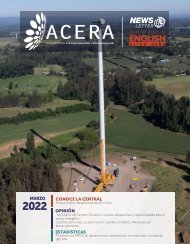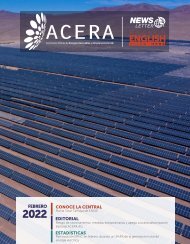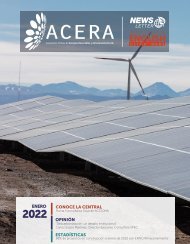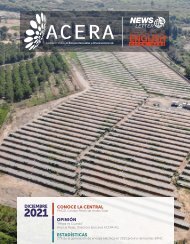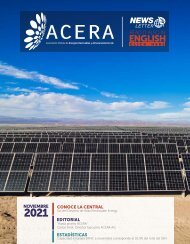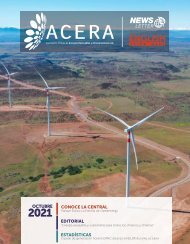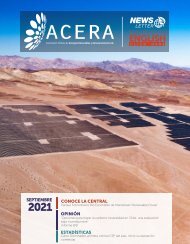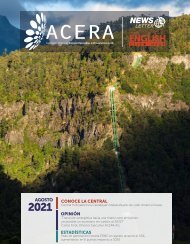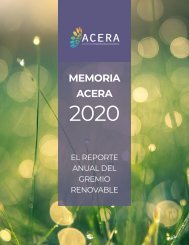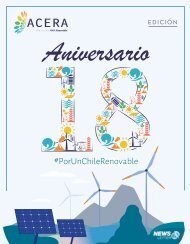Create successful ePaper yourself
Turn your PDF publications into a flip-book with our unique Google optimized e-Paper software.
TAMA TE RA’A<br />
Tecnología: Solar Fotovoltaica<br />
Empresa Socia de <strong>ACERA</strong>: Acciona<br />
Potencia Instalada: 128 kWp<br />
Región: Región de Valparaíso (Rapa Nui)<br />
Punto en el que inyecta: Subestación de Mataveri<br />
*Esta central fue diseñada, construida y donada por ACCIONA a<br />
Sasipa, a través de CORFO, como un primer paso en el proceso de<br />
transición energética de RapaNui hacia las tecnologías renovables.<br />
OPINIÓN<br />
El Doping de la Tierra<br />
Andrés Pesce, Gerente de Sustentabilidad y Nuevos Negocios de FCh.<br />
NOVIEMBRE <strong>2018</strong><br />
NEW!<br />
READ IT ALSO<br />
IN ENGLISH<br />
CLICK HERE<br />
NOTICIAS<br />
Exitosa ExpoERNC <strong>2018</strong>: El evento renovable más importante de la industria...<br />
¡REVISA LA GALERÍA DE FOTOS!<br />
Rapa Nui tiene su primera central fotovoltaica conectada a la Red<br />
<strong>ACERA</strong> se reúne con nuevo Presidente del Coordinador Eléctrico Nacional<br />
ESTADÍSTICAS<br />
En octubre las ERNC aportaron el 21,8% de la energía total del sistema<br />
CONOCE A NUESTROS SOCIOS<br />
Pacific Hydro<br />
Doble Impacto
OPINIÓN<br />
Andrés Pesce<br />
Fundación Chile<br />
El Doping de la Tierra<br />
Hemos estado dopando a la Tierra para sostener el modelo<br />
de producción y consumo lineal. Como todos sabemos,<br />
cuando un atleta se dopa sus resultados de corto plazo<br />
suben a costa de la salud del largo plazo. Este dopaje ha<br />
tomado muchas formas y tiene relación con el uso, un muy<br />
poco tiempo, de recursos que se acumularon durante<br />
cientos de miles de años en nuestro planeta. La liberación<br />
de 1,510 gton de C02 a la atmósfera desde 1850 es quizás<br />
del que más hablamos. Pero éste incluye también el uso de<br />
reservas de aguas subterráneas y de glaciares, el uso de<br />
fertilizantes minerales, el uso de materiales y, más<br />
tristemente, la disminución dramática de la biodiversidad.<br />
¿Cuánto es este “muy poco” tiempo? La verdad es que muy<br />
poco… Si la vida de la Tierra durase un día, la aparición del<br />
homo sapiens habría sucedido cuatro segundos antes de la<br />
medianoche. El desbalance comienza hace unos dos<br />
segundos (cuando el hombre aprende el lenguaje abstracto<br />
y a coordinarse) y acelera hace 4,8 milésimas de segundos,<br />
al inicio de la revolución industrial.<br />
Este desbalance ambiental fue producido por una<br />
proporción pequeña de la población mundial: aquella de los<br />
países que hoy son ricos. Esos países siguieron una<br />
trayectoria de desarrollo lineal en cuanto a uso recursos y<br />
hoy se encuentran muy por encima de la capacidad de la<br />
Tierra para sostener el nivel de vida que tienen. De los 9,8<br />
billones de personas que seremos al 2050, unos ocho<br />
pertenecerán a países en vías de desarrollo que anhelan<br />
tener un nivel de vida similar a la de los países hoy<br />
desarrollados. Ese es el problema. Si queremos generar<br />
crecimiento para mejorar la calidad de vida de estos billones<br />
de personas, debemos generar lógicas de producción y<br />
consumo que se desacoplen del uso de recursos finitos, de<br />
otra forma, la Tierra no será capaz de sostener esa mejor<br />
calidad de vida.<br />
Dentro de este colosal desafío, las energías renovables<br />
tienen un rol protagónico. La Transición Energética es, en<br />
realidad, un eje clave de una transición más amplia hacia<br />
una Economía Circular. Si bien ha avanzado más rápido que<br />
otros, el sector energético, en Chile, tiene la responsabilidad<br />
de liderar por lejos este cambio, fundamentalmente, porque<br />
es un sector que se beneficia de notables desarrollos<br />
tecnológicos y es más fácil de coordinar. En ese plano, al<br />
empuje de los emprendedores, inversionistas, y acciones de<br />
empresas pioneras, se debe sumar la visión de un Estado<br />
capaz de proveer una regulación sensata que coordine esta<br />
transición de una manera justa pero sin timidez.<br />
Andrés Pesce<br />
Gerente de Sustentabilidad y Nuevos Negocios<br />
Fundación Chile
NOTICIAS<br />
¡ÉSTA ES LA PRIMERA PLANTA<br />
GEOTÉRMICA DE SUDAMÉRICA!<br />
EXITOSA EXPOERNC <strong>2018</strong>:<br />
EL EVENTO RENOVABLE MÁS IMPORTANTE DE LA INDUSTRIA<br />
La segunda versión de la ExpoERNC finalizó con total éxito, con una<br />
gran asistencia durante las tres jornadas e importantes panelistas como<br />
protagonistas de la Conferencia. La inauguración estuvo marcada por el<br />
avance que han tenido las energías renovables, así lo destacó también<br />
la Ministra de Energía, Susana Jiménez, quien resaltó que “el sector<br />
Energía lidera, junto a Minería y Obras Públicas, la inversión de <strong>2018</strong>,<br />
superando los US$3.124 millones este año. Este camino debemos<br />
recorrerlo de forma eficiente y segura, pero además sin agotar los<br />
recursos de nuestro planeta y cuidando del medio ambiente”.<br />
La ExpoERNC se consolida como uno de los eventos más importantes<br />
de la industria, con reconocidos expositores, una zona de exposición de<br />
gran calidad y un networking de alto nivel, además de presentar un<br />
fuerte avance en participación femenina en sus paneles de conversación<br />
(32%), lo que se alinea con los avances a nivel público y privado por<br />
caminar hacia la equidad de género en el sector energético. “Estamos<br />
muy satisfechos con este evento porque, además de la alta calidad de<br />
la conferencia, una de las cosas más destacables es el nivel de<br />
contactos que se observa en la feria, lo que refleja la actividad tremenda<br />
que tiene el sector ERNC”, destacó el Director Ejecutivo de <strong>ACERA</strong>,<br />
Carlos Finat.<br />
El evento contó con el patrocinio de relevantes entidades representantes<br />
del sector energético y del ámbito de la sustentabilidad como el<br />
Ministerio de Energía, Ministerio del Medio Ambiente y la Fundación<br />
Imagen de Chile, entre otras importantes organizaciones.<br />
Ministra de Energía, Susana Jiménez<br />
Ministra de Transportes y Telecomunicaciones, Gloria Hutt
GALERÍA DE FOTOS
NOTICIAS<br />
¡ÉSTA ES LA PRIMERA PLANTA<br />
GEOTÉRMICA DE SUDAMÉRICA!<br />
CONOCIENDO EL PARQUE SOLAR QUILAPILÚN<br />
En el marco de la ExpoERNC <strong>2018</strong> se realizó una visita técnica a la<br />
planta solar fotovoltaica Quilapilún, de la empresa Atlas Renewable<br />
Energy, ubicada en la Región Metropolitana (RM). Esta nueva iniciativa<br />
tenía como objetivo acercar las ERNC a la ciudadanía, para ampliar<br />
sus conocimientos técnicos sobre la tecnología y, a la vez, tener la<br />
posibilidad de conocer en terreno cómo funciona una central basada<br />
en energía solar. Quilapilún fue el primer proyecto fotovoltaico a gran<br />
escala de la RM y comenzó su operación a mediados de 2017. Cuenta<br />
con una capacidad instalada de 110 MW y genera alrededor de 243<br />
GWh de electricidad al año.<br />
Fueron 60 las personas afortunadas que se acreditaron a tiempo para<br />
vivir esta experiencia. Uno de los visitantes fue el Director de la<br />
Consultora Systep y académico de la Pontifica Universidad<br />
Católica de Chile, Hugh Rudnick, quien señaló tras la visita que “fue<br />
muy instructiva, con profesionales de la empresa que respondieron a<br />
un exhaustivo interrogatorio de cada uno de los asistentes, desde<br />
temas técnicos especializados a materias ambientales y sociales de la<br />
planta solar”.
NOTICIAS<br />
RAPA NUI TIENE SU PRIMERA CENTRAL FOTOVOLTAICA CONECTADA<br />
A LA RED<br />
En medio del Océano Pacífico, a 3.700 kilómetros de Caldera, se inauguró la planta<br />
fotovoltaica Tama te Ra`a (los primeros rayos del sol), la primera central solar conectada a la<br />
red de distribución de Isla de Pascua, la cual fue donada por ACCIONA a SASIPA (Sociedad<br />
Agrícola y Servicios Isla de Pascua), a través<br />
¡ÉSTA<br />
de CORFO.<br />
ES LA PRIMERA PLANTA<br />
GEOTÉRMICA DE SUDAMÉRICA!<br />
“Esta iniciativa destaca por su innovación y por el cambio de paradigma respecto del tipo de<br />
generación existente hasta hoy en Rapa Nui. Ello porque permitirá transitar desde una<br />
generación basada en combustibles fósiles hacia fuentes limpias y renovables”, dijo la<br />
Ministra de Energía, Susana Jiménez, durante la inauguración.<br />
Por su parte, José Ignacio Escobar, gerente general de Acciona Energía, señaló que “éste<br />
es solo el comienzo de un camino y estamos convencidos de que una isla como esta puede<br />
funcionar 100% con energías renovables y sin el uso de combustibles”.<br />
La instalación, compuesta por 400 paneles solares, conformando un total de 105 kW de<br />
potencia, fue inaugurada a principios de noviembre a través de una ceremonia en la que<br />
<strong>ACERA</strong> participó como invitada especial junto a Pacto Global y Acción Empresas.<br />
Fuente: Revista Electricidad<br />
INTERCAMBIANDO EXPERIENCIAS DE ENERGÍAS<br />
RENOVABLES CON CHINA<br />
China es, sin duda, una de las potencias más importantes del mundo, sobre<br />
todo en lo que a tecnología se refiere, y las energías renovables no han quedado<br />
fuera de esto. Es en ese contexto que nuestro Director de Estudios, Darío<br />
Morales, invitado por la China-Chile Central, viajó al país asiático para<br />
participar de una serie de actividades que abordaron visitas técnicas, además<br />
de su exposición en la Conferencia “Energía Limpia en Chile”, organizada en el<br />
marco de la China International Import Expo - CIIE <strong>2018</strong>, realizada en la ciudad<br />
de Shanghai.<br />
Al respecto, Morales comentó que “es una excelente noticia el interés que<br />
manifestaron las empresas chinas de invertir en energías renovables en Chile, ya<br />
que es una muestra de la confianza que inspira nuestro país para la realización<br />
de inversiones de largo plazo. Además, las empresas manifestaron que ven con<br />
mucho interés el liderazgo que Chile tiene en América del Sur en cuanto al<br />
desarrollo y promoción de las energías renovables, las que además abren la<br />
puerta para el desarrollo de un importante número de negocios relacionados<br />
con la transición energética que el mundo está viviendo”.<br />
Si bien por muchos años el foco de las empresas chinas estuvo puesto en la<br />
instalación de centrales a carbón, hoy sus intereses están puestos en desarrollar<br />
energías renovables, invirtiendo principalmente en solares y eólicas. Visión<br />
alineada con los objetivos que Chile ha venido desarrollando en los últimos<br />
años.
NOTICIAS<br />
<strong>ACERA</strong> SE REÚNE CON NUEVO PRESIDENTE<br />
DEL COORDINADOR ELÉCTRICO NACIONAL<br />
El Coordinador Eléctrico Nacional es uno de los organismos más importantes para el<br />
sector eléctrico chileno y, por ende, también un ente clave para la Asociación Chilena de<br />
Energías Renovables y Almacenamiento, <strong>ACERA</strong> AG. Es por esto, que los directorios de<br />
ambas entidades se dieron cita para llevar a cabo una reunión sobre los principales<br />
avances y desafíos del sector.<br />
La reunión giró en torno a las novedades ¡ÉSTA de ES la asociación, LA PRIMERA como PLANTA su cambio de nombre<br />
y el involucramiento en los temas de género, GEOTÉRMICA además de DE destacar SUDAMÉRICA! lo cerca que está Chile<br />
de alcanzar la meta del 20% de generación renovable al año 2025. Asimismo, se<br />
conversó sobre los plazos referidos a la línea Cardones-Polpaico como uno de los<br />
temas pendientes más importantes para el gremio de las energías renovables.<br />
El Coordinador, por su parte, valoró este tipo de instancias como indispensables para<br />
nutrir su agenda a largo plazo. Al respecto, el Presidente del Consejo Directivo, Juan<br />
Carlos Olmedo -quien asumió el 5 de noviembre de este año-, comentó que “para<br />
nosotros este tipo de reuniones son muy provechosas, puesto que nos permiten obtener<br />
las percepciones de nuestros stakeholders y los desafíos que ellos ven para nuestra<br />
organización y eso nos permite trabajar nuestras áreas de orientación al servicio de esas<br />
necesidades”.<br />
Juan Carlos Olmedo estuvo acompañado en la reunión por los Consejeros Jaime Peralta<br />
y Claudio Espinoza, mientras que por <strong>ACERA</strong> participaron el Presidente de la<br />
Asociación, José Ignacio Escobar, el Vicepresidente, Manuel Tagle, el Director Ejecutivo,<br />
Carlos Finat, además de las Directoras Paola Hartung y Patricia Darez y el Director<br />
Clemente Pérez.<br />
TU EMPRESA<br />
PODRÍA ESTAR<br />
AQUÍ<br />
MEDIA PÁGINA HORIZONTAL<br />
Contacto<br />
Paula Vicens<br />
paula.vicens@acera.cl<br />
+562 22363348
ESTADÍSTICAS<br />
EN OCTUBRE LAS ERNC APORTARON EL 21,8% DE LA ENERGÍA TOTAL DEL SISTEMA<br />
Durante octubre de <strong>2018</strong> el Servicio de Evaluación Ambiental aprobó tres proyectos solares fotovoltaicos que totalizan 268 MW.<br />
Por otra parte, siete proyectos ERNC fueron admitidos a calificación durante este mes, totalizando 392 MW.<br />
En la resolución exenta número 767 del 23 de noviembre de <strong>2018</strong>, publicada por la CNE, once proyectos ERNC fueron declarados en<br />
construcción, sumando 238,6 MW. De estos proyectos, nueve corresponden a tecnología solar fotovoltaica (33,6 MW), uno a biogás (1 MW) y<br />
uno a tecnología eólica (204 MW).<br />
Además, en el mismo documento se anunció que tres proyectos fotovoltaicos entraron en periodo de pruebas, sumando 11,18 MW.<br />
PROYECTOS ERNC POR ESTADO DE AVANCE<br />
12.000<br />
Tipo de Tecnología<br />
Potencia (MW)<br />
10.000<br />
En operación En construcción Aprobado En calificación Total<br />
8.000<br />
Energía Eólica<br />
Solar PV<br />
1.619<br />
2.426<br />
768<br />
274<br />
6.450<br />
14.300<br />
2.646<br />
4.291<br />
11.483<br />
21.291<br />
6.000<br />
CSP<br />
Bioenergía<br />
0<br />
482<br />
110<br />
0<br />
2.192<br />
187<br />
0<br />
30<br />
2.302<br />
700<br />
4.000<br />
Geotérmica<br />
48<br />
0<br />
70<br />
50<br />
168<br />
Mini hidro ERNC<br />
628<br />
93<br />
330<br />
88<br />
1.139<br />
2.000<br />
PSH (Pumped<br />
storage hydro)<br />
0 0 300 0<br />
300<br />
0<br />
Energía Eólica Solar PV CSP Bioenergía Geotérmica Mini hidro ERNC PSH Termosolar<br />
Termosolar<br />
Total<br />
39 0 0 900 939<br />
5.242 1.247 23.829 8.005 38.322<br />
Potencia de proyectos en operación (MW)<br />
Potencia de proyectos aprobados (MW)<br />
Potencia de proyectos en construcción (MW)<br />
Potencia de proyectos en calificación (MW)<br />
POTENCIA ERNC INSTALADA Y EN CONSTRUCCIÓN POR SISTEMA<br />
Sistema Eléctrico Nacional<br />
En Operación<br />
Sistema Eléctrico Nacional<br />
En Construcción<br />
Mini hidro ERNC 604<br />
Solar PV 2.426<br />
Mini hidro ERNC<br />
Solar PV<br />
93<br />
274<br />
Energía Eólica<br />
1.616<br />
Solar CSP<br />
110<br />
Bioenergía<br />
482<br />
Eólica<br />
758<br />
Geotérmica<br />
48<br />
Bioenergía<br />
1<br />
Energía Eólica<br />
Solar PV CSP Bioenergía Geotérmica Mini Hidro
ESTADÍSTICAS<br />
La energía solar fue la que más contribuyó con un 8,59%, lo que significó un aumento del 15% con respecto a la generación del mes<br />
anterior. Le siguió la energía eólica con un 6,78%, aumentando en un 10% con respecto a septiembre de <strong>2018</strong>.<br />
La energía proveniente de centrales mini-hidro estuvo en tercer lugar con 3,64%, representando un aumento del 18% respecto al mes<br />
anterior. A continuación, estuvo el aporte proveniente de bioenergía, con un 2,39%, disminuyendo en un 15% con respecto a septiembre<br />
de <strong>2018</strong>.<br />
Finalmente, estuvo la energía geotérmica que contribuyó con un 0,34%, lo que significó un aumento del 6% con respecto a la generación<br />
del mes anterior.<br />
PORCENTAJE DE PARTICIPACIÓN DE LAS ERNC EN EL SISTEMA<br />
20%<br />
18%<br />
16%<br />
14%<br />
12%<br />
10%<br />
8%<br />
6%<br />
4%<br />
2%<br />
2012 2013 2014 2015 2016 nov.17 dic.17 ene.18 feb.18 mar.18 abr.18 may.18 jun.18 jul.18 ago.18 sep.18 oct.18<br />
Solar Eólico Bioenergía Mini Hidro Geotérmica Total Reconocido Obligación<br />
Porcentaje de participación ERNC Octubre <strong>2018</strong> <strong>2018</strong> YTD<br />
Reconocido<br />
18,92%<br />
Obligación<br />
7,16%<br />
Bioenergía 2,39%<br />
Eólica<br />
6,78%<br />
Hidraúlica<br />
3,64%<br />
Geotérmica<br />
0,34%<br />
Solar<br />
8,59%<br />
15,88%<br />
7,23%<br />
2,99%<br />
5,06%<br />
2,77%<br />
0,27%<br />
6,54%<br />
La información de éste gráfico está desfasada en dos meses.<br />
Total<br />
21,75% 17,63%<br />
Fuente de gráficos: Elaboración propia en base a información de CNE, Coordinador Eléctrico Nacional y SEIA.<br />
BIENVENIDA A LOS<br />
NUEVOS SOCIOS
CONOCIENDO A NUESTROS SOCIOS<br />
Renzo Valentino<br />
GERENTE GENERAL<br />
pacifichydro@pacifichydro.cl<br />
Renzo es peruano, casado y con tres hijas. Es Ingeniero Civil de la Pontificia<br />
Universidad Católica del Perú, MSc en Gerencia de Construcción de<br />
Loughborough University of Technology, UK. Es Gerente general de Pacific<br />
Hydro Chile desde 2008 y cuenta con amplia experiencia en Perú, Canadá,<br />
Venezuela y Colombia.<br />
¿Cuáles son los productos o servicios que entrega su empresa y hacia qué tipo(s)<br />
de ERNC?<br />
Pacific Hydro solo desarrolla proyectos de generación de energía renovable y<br />
nuestro foco ha estado en la generación hidroeléctrica. Operamos tres centrales<br />
de pasada en el Valle del Alto Cachapoal y, además, en joint venture con Statkraft,<br />
contamos con otras dos centrales en la Región de O’Higgins. Recientemente,<br />
inauguramos nuestro primer parque eólico en Chile, Punta Sierra (84 MW), que se<br />
emplaza en la comuna de Ovalle.<br />
¿Cuáles son las novedades o cambios de su empresa en el último tiempo?<br />
Desde 2016 Pacific Hydro es controlada por la empresa china State Power<br />
Investment Corporation (SPIC), la cual es de los mayores generadores de energía<br />
solar del mundo con 10 GW instalados y cuenta con más de 12 GW de energía<br />
eólica. Estamos trabajando y analizando proyectos en este ámbito en Chile.<br />
¿Cuáles son los principales proyectos -o temas- que están trabajando en el<br />
último tiempo en torno a las ERNC o el medioambiente? En caso de ser plantas<br />
de generación, ¿dónde se ubican? ¿Cuáles son sus características centrales?<br />
Nuestros proyectos se caracterizan por ser amigables con el medio ambiente.<br />
Chacayes, incluso, está certificada bajo el Mecanismo de Desarrollo Limpio de<br />
Naciones Unidas. Nuestra atención está en desarrollar clusters que aporten<br />
sinergia a nuestros proyectos en operación existentes.<br />
¿Qué elementos caracterizan y/o diferencian a su empresa?<br />
Un sello de Pacific Hydro es su relación con las comunidades, que entendemos<br />
como parte del desarrollo sostenible que debe tener nuestro negocio. Las<br />
comunidades deben incorporarse en la planificación estratégica del negocio en<br />
todas las etapas de su desarrollo, por eso, contamos con una política de<br />
desarrollo comunitario.<br />
¿Cuál considera que es la importancia de la participación ER en el sistema<br />
eléctrico del país?<br />
Las energías renovables ya son una realidad en Chile, su potencial es enorme y<br />
estamos convencidos que pueden apoyar la transformación de nuestra sociedad.<br />
No solo queremos que la matriz energética sea más verde, al mismo tiempo<br />
queremos que sea segura, eficiente y competitiva. Ser sustentable es poder<br />
equilibrar todos estos elementos.<br />
¿Por qué recomendaría ser socio de <strong>ACERA</strong>?<br />
Con <strong>ACERA</strong> compartimos una visión: las energías renovables son el presente y<br />
futuro de Chile y son esenciales para un desarrollo sostenible. Creemos que<br />
juntos, uniendo nuestras experiencias, compartiendo buenas prácticas,<br />
participando en la discusión de las regulaciones que nos competen, podemos<br />
seguir avanzando hacia un Chile más renovable y limpio.<br />
Anita Rivera<br />
RESPONSABLE ÁREA DE<br />
NATURALEZA Y MEDIO AMBIENTE<br />
arivera@dobleimpacto.cl<br />
Anita es chilena y está esperando a su primer hijo. Se ha especializado en<br />
gestión de proyectos y sustentabilidad aplicada trabajando en diversas<br />
organizaciones dentro y fuera de Chile, tales como The Big Issue Invest,<br />
Oxitec, TriCiclos y Regenerativa, donde fue Directora Ejecutiva antes de<br />
entrar a Doble Impacto.<br />
¿Cuáles son los productos o servicios que entrega su empresa y hacia qué tipo(s)<br />
de ERNC?<br />
Nuestro servicio es estructurar créditos a medida, considerando las variables<br />
particulares de cada negocio y buscando que el financiamiento sea un aporte a<br />
mejorar el impacto y sostenibilidad de las iniciativas. Estamos abiertos a todas las<br />
ERNC, pero hemos comenzado por la energía solar.<br />
¿Cuáles son las novedades o cambios de su empresa en el último tiempo?<br />
Doble Impacto ha crecido significativamente este año, consolidándose como el<br />
primer proyecto bancario con lineamientos de banca ética en Chile. Hemos<br />
estructurado el negocio en torno a tres áreas (cultura y educación; desarrollo<br />
social e inclusión; naturaleza y medioambiente) lideradas todas por un potente<br />
equipo multidisciplinario con una mirada experta y comercial.<br />
¿Cuáles son los principales proyectos -o temas- que están trabajando en el<br />
último tiempo en torno a las ERNC o el medioambiente? En caso de ser plantas<br />
de generación, ¿dónde se ubican? ¿Cuáles son sus características centrales?<br />
Dado que el escenario de la ERNC en Chile es bastante técnico y complejo, hoy<br />
estamos explorando cómo abordar las necesidades de financiamiento del sector<br />
para poder ofrecer una alternativa competitiva e innovadora, dada la realidad que<br />
tenemos como proyecto bancario actualmente.<br />
¿Qué elementos caracterizan y/o diferencian a su empresa?<br />
Buscamos empresas e instituciones que estén lideradas por equipos interesados<br />
en contribuir a mejorar la calidad de vida de las personas y el cuidado del planeta,<br />
que ya tengan esta mirada en su core de negocio o que quieran avanzar de forma<br />
concreta por este camino.<br />
¿Cuál considera que es la importancia de la participación ERNC en el sistema<br />
eléctrico del país?<br />
Es de gran importancia avanzar hacia una matriz descarbonizada en Chile para<br />
contribuir a la reducción de GEI y un ambiente más limpio. Debemos seguir<br />
aprovechando nuestra condición de líderes regionales en la materia y empujar<br />
porque las metas país y de la Agenda 2030 se cumplan cuanto antes.<br />
¿Por qué recomendaría ser socio de <strong>ACERA</strong>?<br />
Porque es una excelente red dentro del mundo de las ERNC, que te permite estar<br />
al tanto de todas las noticias y avances tecnológicos del sector en Chile y el<br />
mundo. Me encanta la forma en que canalizan la información disponible y todas<br />
las actividades en las que se puede participar. Lo recomiendo mucho para quien<br />
quiere adentrarse en esta temática y conocer en más detalle el sector.
EVENTOS<br />
DICIEMBRE<br />
EVENTOS DEL MES<br />
12 al<br />
13<br />
Curso práctico: Sistemas Fotovoltaicos Bifaciales<br />
Camchal<br />
Santiago - Chile<br />
Revisar aquí<br />
2019<br />
EVENTOS DEL AÑO<br />
ENERO<br />
26 de febrero al<br />
01 de marzo<br />
GENERA 2019<br />
IFEMA<br />
España -Madrid<br />
Revisar aquí<br />
MARZO<br />
19<br />
Cena Anual de las Energías Renovables 2019<br />
<strong>ACERA</strong><br />
Santiago - Chile<br />
Revisar aquí<br />
27<br />
al<br />
28<br />
Innovación Ciudad Futuro<br />
Práxedis y Finnova<br />
Santiago - Chile<br />
Revisar aquí<br />
ABRIL<br />
02 al<br />
08 al<br />
04<br />
11<br />
CIREC Week 2019<br />
Green Power<br />
Santiago - Chile<br />
Revisar aquí<br />
CESCO Week <strong>2018</strong><br />
CESCO<br />
Santiago - Chile<br />
Revisar aquí<br />
MAYO<br />
27 al<br />
30<br />
ExpoNor 2019<br />
Asociación de Industriales de Antofagasta<br />
Antofagasta - Chile<br />
Revisar aquí
¡ÉSTA ES LA PRIMERA PLANTA<br />
GEOTÉRMICA DE SUDAMÉRICA!<br />
<strong>ACERA</strong>, Asociación Chilena de<br />
Energías Renovables y<br />
Almacenamiento A.G.<br />
General del Canto 230, Of 601<br />
Providencia, Santiago<br />
+562 2236 3348<br />
informaciones@acera.cl<br />
@<strong>ACERA</strong>AG<br />
<strong>ACERA</strong><br />
@acera.ag
TAMA TE RA’A<br />
Technology: Solar Photovoltaic<br />
<strong>ACERA</strong>’s Member Company: Acciona<br />
Installed Power: 128 kWp<br />
Region: Valparaíso Region (Rapa Nui)<br />
Injecting Point: Mataveri Substation<br />
*This plant was designed, built and donated by ACCIONA to Sasipa,<br />
through CORFO, as a first step in the process of Rapa Nui’s energy<br />
transition process towards renewable technologies.<br />
OPINION<br />
The Earth’s Doping<br />
Andrés Pesce, Manager of Sustainability and New Businesses of FCh.<br />
NOVEMBER <strong>2018</strong><br />
NEWS<br />
Succesfull ExpoERNC <strong>2018</strong>: The industry’s most important renewable event.<br />
Check the photo gallery!<br />
Rapa Nui has its first solar photovoltaic plant connected to the grid<br />
<strong>ACERA</strong> meets the new President of the National Electric Coordinator<br />
STATISTICS<br />
In October, NCRE contributed 21.8% to the total energy system<br />
MEET OUR MEMBER COMPANIES<br />
Pacific Hydro<br />
Doble Impacto
OPINION<br />
Andrés Pesce<br />
Fundación Chile<br />
The Earth’s Doping<br />
We have been doping the Earth to sustain the production<br />
and linear consumption model. As we all know, when an<br />
athlete dopes up, his results improve in the short term at the<br />
expense of his health in the long term. The earth’s doping<br />
has taken many forms, and has to do with the use, in a very<br />
short period of time, of resources that had been<br />
accumulating for hundreds of thousands of years in our<br />
planet. The release of 1,510 gton of CO2 into the<br />
atmosphere since 1850 is probably the most mentioned, but<br />
we must also include the use of groundwater and glaciar<br />
reserves, the use of mineral fertilisers, the use of materials,<br />
and most sadly of all, the dramatic decrease of biodiversity.<br />
How much is this “short period of time”? The truth is, very<br />
short… If life on Earth lasted one day, the appearance of<br />
homo sapiens would have occurred four seconds before<br />
midnight. The imbalance started some two seconds ago<br />
(when men learnt abstract language and began to<br />
coordinate), and accelerated 4.8 milliseconds ago, with the<br />
beginning of the industrial revolution.<br />
This environmental imbalance was produced by a small<br />
proportion of the world’s population, namely the nowadays<br />
rich countries. These countries followed a linear<br />
development pathway in the use of resources and today they<br />
are far beyond the Earth’s capacity of sustaining their<br />
standard of living. Approximately eight of the 9.8 billion<br />
people we will be by 2050, will belong to developing<br />
countries which yearn for a living standard similar to the<br />
nowadays developed countries. This is the problem. If we<br />
want to generate growth to improve the quality of life of all of<br />
these people, we must generate logics of production and<br />
consumption that de-couple from the use of finite resources.<br />
Otherwise, the Earth will no be able to sustain this better<br />
quality of life.<br />
Renewable energies have a leading role in this huge<br />
challenge. The Energy Transition is actually a key factor for a<br />
broader transition towards a Circular Economy. Though it<br />
has progressed faster than others, the energy sector in Chile<br />
is responsible of leading this change, mainly because it’s a<br />
sector that benefits from significant technological<br />
developments and is easier to coordinate. At this level, in<br />
addition to the drive of entrepreneurs, investors, and the<br />
actions of pioneering companies, a State vision that provides<br />
reasonable regulations to coordinate this transition in a fair<br />
but fearless way is required.<br />
Andrés Pesce<br />
Manager of Sustainability and New Businesses of FCh.<br />
Fundación Chile
NEWS<br />
¡ÉSTA ES LA PRIMERA PLANTA<br />
GEOTÉRMICA DE SUDAMÉRICA!<br />
SUCCESFULL EXPOERNC <strong>2018</strong>: THE INDUSTRY’S MOST IMPORTANT RENEWABLE EVENT<br />
The second version of ExpoERNC was a complete success, with a huge<br />
attendance during the three days and important speakers as<br />
protagonists of the Conference. The inauguration was marked by the<br />
progress of renewable energies, as highlighted by the Minister of<br />
energy, Susana Jiménez, who said that “the Energy sector, together<br />
with Mining and Public Works, lead the <strong>2018</strong> investment, exceeding US$<br />
3,124 million this year. We must walk the path in an efficient and safe<br />
way, without depleting our planet’s resources and caring for the<br />
environment”.<br />
The ExpoERNC is positioning itself as one of the industry’s most<br />
important events, with renowned exhibitors, a high-quality exhibition<br />
zone and a high-level networking. It also showed a strong advance in<br />
female participation in its panel discussions (32%), which coincides with<br />
the improvement at the public and private levels in moving towards<br />
gender equity within the energy sector. “We are very satisfied with this<br />
event because, in addition to the high quality of the conference, one of<br />
the most remarkable aspects is the level of contacts we can see at the<br />
fair, which reflects the huge activity of the NCRE sector”, highlighted<br />
<strong>ACERA</strong>’s Executive Director, Carlos Finat.<br />
The event was sponsored by prominent entities representing the energy<br />
sector and the sustainability area such as the Ministry of Energy, the<br />
Ministry of Environment and the Fundación Imagen de Chile, among<br />
other important organizations.<br />
Minister of Energy, Susana Jiménez<br />
Minister of Transport and Telecommunications, Gloria Hutt
PHOTO GALLERY
NEWS<br />
¡ÉSTA ES LA PRIMERA PLANTA<br />
GEOTÉRMICA DE SUDAMÉRICA!<br />
GETTING TO KNOW THE QUILAPILUN SOLAR PARK<br />
A technical visit was made as part of ExpoERNC <strong>2018</strong> to the Quilapilun<br />
solar photovoltaic plant, of Atlas Renewable Energy, located in the<br />
Metropolitan Region (RM). This new initiative was carried out to draw<br />
the NCRE nearer to the citizens to broaden their technical knowledge<br />
of the technology, in addition to getting to know in the field how a plant<br />
based on solar power works. Quilapilun was the first large-scale<br />
photovoltaic project in the MR and started operating by mid 2017. It<br />
has an installed capacity of 110 MW and generates about 243 GWh of<br />
electricity per year.<br />
Sixty people were lucky to accredit on time to live this experience. One<br />
of them was the Director of the Systep Consulting Firm and<br />
academic from the Pontifica Universidad Católica de Chile, Hugh<br />
Rudnick, who stated after the visit that “it was very enlightening, where<br />
the company’s professionals answered an extensive questioning from<br />
every attendee involving specialized technical topics as well as<br />
environmental and social aspects of the solar plant”.
NEWS<br />
RAPA NUI HAS ITS FIRST SOLAR PHOTOVOLTAIC PLANT CONNECTED<br />
TO THE GRID<br />
In the middle of the Pacific Ocean, 3,700 kilometers from Caldera, the Tama te Ra`a (first sun<br />
rays) photovoltaic plant was inaugurated, being the first solar plant connected to the Easter<br />
Island electric distribution grid, donated by ACCIONA to SASIPA (Sociedad Agrícola y<br />
Servicios Isla de Pascua), through CORFO.<br />
¡ÉSTA ES LA PRIMERA PLANTA<br />
GEOTÉRMICA DE SUDAMÉRICA!<br />
As stated by the Minister of Energy, Susana Jiménez, during the inauguration, “this initiative<br />
stands out for its innovation and the paradigm shift concerning the kind of generation Rapa<br />
Nui had until today. This will allow to move from a fossil-fuel based generation towards clean<br />
and renewable sources”.<br />
José Ignacio Escobar, general manager of Acciona Energía, stated, for his part, that “this<br />
is just the beginning of a path and we are certain that an island as this one may function 100%<br />
with renewable energies without using fossil fuels”.<br />
The plant, composed of 400 solar panels, with a total power of 105 kW, was inaugurated at<br />
the beginning of November in a ceremony where <strong>ACERA</strong> took part as a special guest together<br />
with Pacto Global and Acción Empresas.<br />
Source: Electricidad Magazine<br />
EXCHANGING EXPERIENCES IN RENEWABLE<br />
ENERGIES WITH CHINA<br />
There is no doubt that China is one of the most important world powers,<br />
particularly in technology, including renewable energies. In this context, our<br />
Studies Director, Dario Morales, invited by China-Chile Central, travelled to<br />
the Asian country to take part in a range of activities that included technical<br />
visits and a lecture in the Conference “Clean Energy in Chile”, organized within<br />
the framework of the China International Import Expo - CIIE <strong>2018</strong>, carried out<br />
in Shanghai.<br />
In this respect, Morales commented that “the interest shown by Chinese<br />
companies in investing in renewable energies in Chile has been an excellent<br />
news, since it shows the confidence our country inspires for carrying out<br />
long-term investments. The companies also expressed their interest in the<br />
Chilean leading role in South America regarding the development and<br />
promotion of renewable energies, which opens the path for the development<br />
of a large number of businesses related to the worldwide energy transition”.<br />
Though the focus of Chinese companies had been placed on the installation<br />
of coal plants, nowadays they are interested in developing renewable<br />
energies, investing mainly in solar and wind technologies, a vision that<br />
coincides with the objectives developed by Chile during the last few years.
NEWS<br />
<strong>ACERA</strong> MEETS THE NEW PRESIDENT OF THE NATIONAL<br />
ELECTRIC COORDINATOR<br />
The National Electric Coordinator is one of the most important agencies within the<br />
Chilean electricity sector and, therefore, a key entity for the Chilean Association of<br />
Renewable Energies and Storage, <strong>ACERA</strong> AG. This is why the Board of Directors of<br />
both institutions met to discuss the main developments and challenges of the sector.<br />
The meeting focused on <strong>ACERA</strong>’s innovations such as its change of name and<br />
involvement on gender issues, as well ¡ÉSTA as standing ES LA PRIMERA out how near PLANTA is Chile from reaching<br />
the goal of 20% renewable generation GEOTÉRMICA by 2025. It DE also SUDAMÉRICA!<br />
referred to the terms of the<br />
Cardones-Popaico line as one of the most important pending issues of the renewable<br />
energy sector.<br />
The Coordinator valued this kind of activities as an essential feedback for its long-term<br />
agenda. The Chairman of the Board of Directors, Juan Carlos Olmedo – who took<br />
over last November 5, stated that “this kind of meetings are highly beneficial, since they<br />
give us the chance of getting to know the views of our stakeholders and the challenges<br />
they see for our organization, which allows us to focus our work at the service of those<br />
requirements”.<br />
Juan Carlos Olmedo was accompanied at this meeting by the Advisors Jaime Peralta<br />
and Claudio Espinoza, while on <strong>ACERA</strong>’s part attended the Association’s President,<br />
José Ignacio Escobar, its Vice President, Manuel Tagle, its Executive Director, Carlos<br />
Finat, in addition to the Directors Paola Hartung, Patricia Darez, and Clemente Pérez.<br />
YOUR COMPANY<br />
COULD BE<br />
HERE<br />
HALF PAGE HORIZONTAL<br />
Contact<br />
Paula Vicens<br />
paula.vicens@acera.cl<br />
+562 22363348
STATISTICS<br />
IN OCTOBER, NCRE CONTRIBUTED 21.8% TO THE TOTAL ENERGY SYSTEM<br />
During November <strong>2018</strong>, the Environmental Assessment Service granted the environmental approval to three solar photovoltaic projects, totaling<br />
268 MW.<br />
On the other hand, seven NCRE projects were admitted to environmental permit process during this month, totaling 392 MW.<br />
In the Exempt Resolution Nº 767 of November 23, <strong>2018</strong>, published by the National Energy Commission - CNE, eleven NCRE projects -totaling<br />
238.6 MW- were declared in construction, nine of which are of solar PV technology (33.6 MW) one of biogas (1 MW), and one of wind technology<br />
(204 MW).<br />
In addition, the same document announced that three NCRE projects began their test period, totaling 11.18 MW.<br />
NCRE PROJECTS BY STATUS<br />
12.000<br />
10.000<br />
Technology<br />
Capacity (MW)<br />
Installed Under construction Approved<br />
Admitted to<br />
environmental<br />
permit process<br />
Total<br />
8.000<br />
Wind energy<br />
Solar PV<br />
1.619<br />
2.426<br />
768<br />
274<br />
6.450<br />
14.300<br />
2.646<br />
4.291<br />
11.483<br />
21.291<br />
6.000<br />
CSP<br />
0<br />
110<br />
2.192<br />
0<br />
2.302<br />
Bioenergy<br />
482<br />
0<br />
187<br />
30<br />
700<br />
4.000<br />
Geothermal<br />
48<br />
0<br />
70<br />
50<br />
168<br />
Mini hydro NCRE<br />
628<br />
93<br />
330<br />
88<br />
1.139<br />
2.000<br />
PSH (Pumped<br />
storage hydro)<br />
0 0 300 0<br />
300<br />
0<br />
Wind energy Solar PV CSP Bioenergy Geothermal Mini hydro NCRE PSH Termosolar<br />
Thermosolar<br />
Total<br />
39 0 0 900 939<br />
5.242 1.247 23.829 8.005 38.322<br />
Installed capacity (MW)<br />
Approved capacity (MW)<br />
Capacity under construction (MW)<br />
Capacity admitted to environmental permit process (MW)<br />
INSTALLED AND UNDER CONSTRUCTION NCRE POWER PER SYSTEM<br />
National Electrical System<br />
Installed Capacity<br />
Mini hydro NCRE 604<br />
Solar PV 2.426<br />
National Electrical System<br />
Under Construction<br />
Mini hydro NCRE 93<br />
Solar PV 274<br />
Wind energy<br />
1.616<br />
Solar CSP<br />
110<br />
Bioenergy<br />
482<br />
Wind energy<br />
758<br />
Geothermal<br />
48<br />
Bioenergy<br />
1<br />
Wind energy Solar PV CSP Bioenergy Geothermal Mini hydro NCRE
STATISTICS<br />
The highest contribution was solar energy, with an 8.59%, which represents a 15% increase as compared to prior month’s generation,<br />
followed by wind energy with a 6.78%, increasing by 10% with respect to September, <strong>2018</strong>.<br />
Energy from mini hydro plants was placed third with a 3.64%, representing a 18% increase, followed by bioenergy, with a 2.39%, which<br />
represents a 15% decrease as compared to September, <strong>2018</strong>.<br />
Finally, geothermal energy contributed with a 0.34%, which meant a 6% increase as compared to the prior month’s generation.<br />
NCRE’S PERCENTAGE OF PARTICIPATION<br />
20%<br />
18%<br />
16%<br />
14%<br />
12%<br />
10%<br />
8%<br />
6%<br />
4%<br />
2%<br />
2012 2013 2014 2015 2016 nov.17 dec.17 jan.18 feb.18 mar.18 apr.18 may.18 jun.18 jul.18 aug.18 sep.18 oct.18<br />
Solar Wind Bioenergy Mini hydro NCRE Geothermal Total Recognized Legal Requirement<br />
NCRE’s percentage of participation October <strong>2018</strong> <strong>2018</strong> YTD<br />
Recognized<br />
Legal Requirement<br />
Bioenergy<br />
Wind<br />
Mini hydro NCRE<br />
Geothermal<br />
Solar PV<br />
Total<br />
18.92%<br />
15.88%<br />
7.16%<br />
7.23%<br />
2.39%<br />
2.99%<br />
6.78%<br />
5.06%<br />
3.64%<br />
2.77%<br />
0.34%<br />
0.27%<br />
8.59%<br />
6.54%<br />
21.75% 17.63%<br />
Information in this graphic is two months behind<br />
Source of graphics: Developed by <strong>ACERA</strong> based on information from CNE, National Electrical Coordinator and SEIA<br />
WELCOME TO<br />
NEW MEMBERS
MEET OUR MEMBERS<br />
Renzo Valentino<br />
GENERAL MANAGER<br />
pacifichydro@pacifichydro.cl<br />
Renzo is Peruvian, married and has three daughters. He is a Civil Engineer<br />
from the Pontificia Universidad Católica del Perú, with a MSc degree in<br />
Construction Management from the Loughborough University of Technology,<br />
UK. He has been the General Manager of Pacific Hydro Chile since 2008 and<br />
has a broad experience in Peru, Canada, Venezuela, and Colombia.<br />
What products or services does your company deliver and to what kind(s) of<br />
NCREs?<br />
Pacific Hydro develops only renewable energy generation projects, focused on<br />
hydroelectric power generation. We are operating three run-of-river plants in the<br />
Alto Cachapoal Valley in addition to other two plants, in joint venture with<br />
Statkraft, in the O’Higgins Region. We recently opened our first wind farm in<br />
Chile, Punta Sierra (84 MW), located in the Ovalle commune.<br />
Which have been the latest new services or changes introduced by your<br />
Company?<br />
Since 2016, Pacific Hydro has been controlled by the Chinese company State<br />
Power Investment Corporation (SPIC), which is one of the largest solar power<br />
generators in the world, with 10 installed GW and over 12 GW of wind power. We<br />
are working on and analyzing this kind of projects in Chile.<br />
What are the main projects -or themes- you have been recently working on<br />
concerning NCRE or the environment? In case they are generation plants, where<br />
are the located and which are their main characteristics?<br />
Our projects are characterized by being environmentally friendly. Chacayes is<br />
even certified by the Clean Development Mechanism of the United Nations. We<br />
focus on developing clusters that will bring synergy to our current operating<br />
projects.<br />
Which elements characterize and/or distinguish your company?<br />
A distinctive characteristic of Pacific Hydro is its relationship with communities,<br />
which we consider part of the sustainable development of our business.<br />
Communities must be incorporated in the business strategic planning at all of its<br />
development stages, and therefore we have a community development policy.<br />
How important is NCRE participation in the Chilean electric system?<br />
Renewable energies are already a reality in Chile. They have a huge potential and<br />
we are certain they can help to transform our society. We not only want a greener<br />
power matrix, but we want it to be safe, efficient and competitive. Sustainability<br />
involves being able to achieve a balance between all these elements.<br />
Why would you recommend being an <strong>ACERA</strong> member?<br />
We share a vision with <strong>ACERA</strong>: renewable energies are the present and future of<br />
Chile and are essential for a sustainable development. We believe that together,<br />
uniting our experiences, sharing good practice, taking part in the discussion of the<br />
regulations that fall to us, we can keep moving towards a more renewable and<br />
cleaner Chile.<br />
Anita Rivera<br />
RESPONSIBLE OF THE NATURE<br />
AND ENVIRONMENT AREA<br />
arivera@dobleimpacto.cl<br />
Anita is Chilean and expecting her first child. She has specialized in project<br />
management and applied sustainability working in several organizations in<br />
Chile and abroad, such as The Big Issue Invest, Oxitec, TriCiclos, and<br />
Regenerativa, where she was Executive Director before joining Doble<br />
Impacto.<br />
What products or services does your company deliver and to what kind(s) of<br />
NCREs?<br />
Our service involves structuring custom-made credits, considering each<br />
business’ particular variables and having in mind that the financing should<br />
contribute to improve the impact and sustainability of the initiatives. We are open<br />
to all NCRE, but we have begun with solar power.<br />
Which have been the latest new services or changes introduced by your<br />
Company?<br />
Doble Impacto has grown significantly this year and has consolidated as the first<br />
banking project with ethical banking guidelines in Chile. We have structured our<br />
business around three areas (culture and education; social development and<br />
inclusion; nature and environment), all of them led by a strong multidisciplinary<br />
team with an expert and commercial vision.<br />
What are the main projects -or themes- you have been recently working on<br />
concerning NCRE or the environment? In case they are generation plants, where<br />
are the located and which are their main characteristics?<br />
Since the Chilean NCRE stage is quite technical and complex, we are exploring<br />
the way of facing the sector’s financing requirements in order to be able to offer a<br />
competitive and innovating alternative, given our present reality as banking<br />
project.<br />
Which elements characterize and/or distinguish your company?<br />
We are looking for companies and institutions led by teams interested in<br />
contributing to improve people’s life quality and the care of the planet, having<br />
already this vision in their business core, or wishing to move concretely in this<br />
direction.<br />
How important is NCRE participation in the Chilean electric system?<br />
It is highly important to move towards a decarbonized matrix in Chile to contribute<br />
to the GHG reduction and a cleaner environment. We must keep taking<br />
advantage of our regional leadership in this matter and compel the achievement<br />
of the country’s goals and the 2030 Agenda as soon as possible.<br />
Why would you recommend being an <strong>ACERA</strong> member?<br />
Because it is an excellent network within the NCRE world that makes it easier to<br />
keep up-to-date of all the news and technological advances of the sector in Chile<br />
and abroad. I love their way of channeling the available information and all the<br />
activities you can take part in. I highly recommend it for those who want to go<br />
deeper into this subject and have a more detailed view of the sector.
EVENTS<br />
DECEMBER<br />
EVENTS OF THE MONTH<br />
12 to<br />
13<br />
Practical Course: Bifacial Phovoltaic Systems<br />
Camchal<br />
Santiago - Chile<br />
Click here<br />
<strong>2018</strong><br />
EVENTS OF THE YEAR<br />
JANUARY<br />
26<br />
February<br />
to march 01<br />
GENERA 2019<br />
IFEMA<br />
Spain -Madrid<br />
Click here<br />
MARCH<br />
19<br />
2019 Annual Renewable Energies Dinner<br />
<strong>ACERA</strong><br />
Santiago - Chile<br />
Click here<br />
27<br />
to<br />
28<br />
Innovación Ciudad Futuro<br />
Práxedis y Finnova<br />
Santiago - Chile<br />
Click here<br />
APRIL<br />
02 to<br />
08 to<br />
04<br />
11<br />
CIREC Week 2019<br />
Green Power<br />
Santiago - Chile<br />
Click here<br />
CESCO Week <strong>2018</strong><br />
CESCO<br />
Santiago - Chile<br />
Click here<br />
MAY<br />
27 to<br />
30<br />
ExpoNor 2019<br />
Asociación de Industriales de Antofagasta<br />
Antofagasta - Chile<br />
Click here
<strong>ACERA</strong>, Chilean Association of<br />
Renewable Energies and<br />
Storage A.G.<br />
General del Canto 230, Of 601<br />
Providencia, Santiago<br />
+562 2236 3348<br />
informaciones@acera.cl<br />
@<strong>ACERA</strong>AG<br />
<strong>ACERA</strong><br />
@acera.ag






